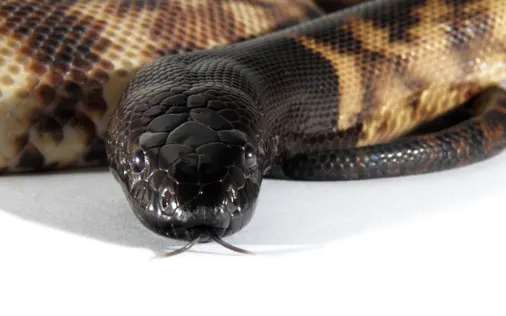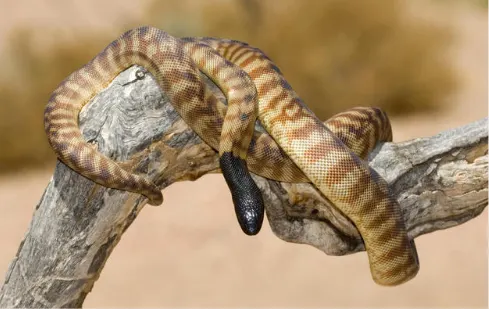The black-headed python, scientifically known as Aspidites melanocephalus, is a unique and fascinating species native to the northern regions of Australia. Known for its distinctive shiny black head, this nonvenomous constrictor plays an essential role in its ecosystem and has become a popular subject of interest among herpetologists and reptile enthusiasts.
Table of Contents
Scientific Classification
- Kingdom: Animalia
- Phylum: Chordata
- Class: Reptilia
- Order: Squamata
- Family: Pythonidae
- Genus: Aspidites
- Scientific Name: Aspidites melanocephalus

Conservation Status
The black-headed python is classified as “Least Concern” by the IUCN Red List. This status reflects a stable population and an extensive range, indicating that the species is not currently at risk of significant decline.
Physical Characteristics
black-headed pythons are visually striking, primarily due to their black heads, which can absorb heat while the rest of their bodies remain hidden and safe. This adaptation allows them to thermoregulate efficiently. Their bodies display bands or brindle patterns in colors ranging from black, grey, and gold to tan and cream. They typically range from 5 to 11 feet in length and have a somewhat flattened appearance with a thin, tapered tail.
Habitat and Distribution
The black-headed python is endemic to the northern half of Australia, inhabiting regions ranging from humid tropical to semi-arid environments. They often hide in loose debris, rocks, hollow logs, and termite mounds during the day, becoming more active at night and early morning.
Diet and Hunting Behavior
These pythons are primarily ambush predators, preying on cold-blooded animals such as goannas, dragons, blue-tongued skinks, and other snakes, including venomous ones. They also consume birds and mammals when the opportunity arises. Their muscular bodies allow them to constrict and subdue prey efficiently, and their black heads can be used to draw in larger prey items more easily.
Reproduction
Black-headed pythons mate between July and September, with females laying eggs from October through November. Females coil around their eggs to incubate them until they hatch. Hatchlings are independent from birth and can begin hunting within a few days.
Evolution and Origins
The black-headed python’s ancestry can be traced back to the Late Cretaceous period, approximately 94-112 million years ago. Snakes evolved from burrowing lizards, with the ancestors of modern pythons appearing around 73 million years ago. The black-headed python, along with its close relative, the woma python, belongs to the Aspidites genus, which means “shield-bearer” in Greek, referring to the shield-shaped scales on their heads.
Human Interaction
Despite their formidable appearance, black-headed pythons are docile and rarely aggressive towards humans. When threatened, they may hiss or strike with a closed mouth but seldom bite. This behavior, along with their nonvenomous nature, makes them relatively safe to handle. Due to their calm demeanor, they have become popular in the exotic pet trade, especially since they breed readily in captivity.
Conservation and Population
While the black-headed python is not currently at risk, it is important to monitor their populations and habitats to ensure they remain stable. These pythons are occasionally captured for the pet trade and by Aboriginal groups for
Captive Care
Black-headed pythons are becoming increasingly popular as pets due to their manageable size and calm nature. They require a large enclosure to accommodate their length and provide ample space for them to move and hide. Proper care includes maintaining suitable temperatures, providing a varied diet, and ensuring a clean and secure habitat.
The black-headed python is a remarkable species that has adapted well to its environment. Its unique physical characteristics, such as its heat-absorbing black head, and its role as an ambush predator, make it a fascinating subject of study. Whether in the wild or as a pet, this python continues to captivate those who encounter it, showcasing the incredible diversity of Australia’s wildlife.
FAQs About Black-Headed Pythons
Are black-headed pythons venomous?
No, black-headed pythons are nonvenomous and not dangerous to humans. They are docile and prefer to avoid confrontation.
How do black-headed pythons hunt?
Black-headed pythons are primarily ambush predators. They lie in wait for their prey, using their muscular bodies to constrict and subdue it.
What do black-headed pythons eat?
Their diet mainly consists of lizards and snakes, but they also eat birds and mammals when available. They have a particular preference for venomous snakes.
What is the purpose of their black head?
The black head of the python functions as a solar panel, absorbing heat from the sun. This allows the snake to regulate its body temperature while keeping most of its body hidden.

How large do black-headed pythons get?
Black-headed pythons typically range from 5 to 11 feet in length. They are muscular with a somewhat flattened appearance and a thin, tapered tail.
How do black-headed pythons reproduce?
They mate between July and September, and females lay eggs from October through November. The female coils around the eggs to incubate them until they hatch. Hatchlings are independent from birth.
Are black-headed pythons good pets?
Yes, due to their manageable size and calm nature, black-headed pythons have become popular pets. They require a large enclosure and proper care to thrive in captivity.
- Enchi Ball Python: A Unique and Stunning Morph of Python regius - March 27, 2025
- Emerald Tree Monitor: The Enigmatic Green Guardian of the Rainforest - March 26, 2025
- The Egyptian Cobra (Naja haje): A Fascinating Serpent - March 25, 2025
